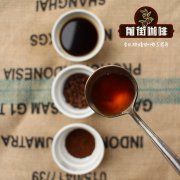The grading system of Colombian coffee beans? The history of Colombian coffee? Colombia

Professional coffee knowledge exchange more coffee bean information please follow the coffee workshop (Wechat official account cafe_style)
The grading system of Colombian coffee beans? The history of Colombian coffee? How do you drink Colombian coffee?
Colombia is currently the second largest coffee producer in the world, using washing to treat Arabica coffee beans. It is also one of the largest producers of high-quality coffee in the world. Traditional deep-roasted coffee has a strong and memorable flavor. Coffee was first introduced to Colombia in 1808, when it was brought by a priest from French Antilles via Venezuela. Today, the country is the third largest coffee producer after Brazil and Vietnam, with an annual output of 12 million bags of 60 kg each, while Brazil produces 31 million bags a year. The main production areas of Colombia are in the central and eastern mountains. The most important plantations along the central mountains are located in Medellin, Almenia and Manisales. Among the above three areas, Medellin coffee is of the best quality and high price, which is characterized by full grains, rich nutrition, rich aroma and moderate acidity. Taken together, these three areas are referred to as MAM. Along the eastern mountains, the two best areas are around Bogota and then north around Bukamanga. Bogota coffee is less acidic than Medellin coffee, but the two are of the same quality. German imports account for 25 per cent of Colombia's total exports, reflecting the excellent quality of the country's coffee.
The coffee grade is divided into Supermo, Excelso and UGQ. Cross coffee in the excellent grade is exported to Germany and Europa coffee is exported to Nordic countries. Excellent grade coffee and top coffee can be bought in most coffee shops. The difference between the two professional regulations is that the coffee beans used in top coffee are larger, and the raw materials are taken from newly harvested coffee beans, so it is easier to ensure the quality of the products. Excellent coffee is usually softer and slightly more acidic than top coffee, but both are aromatic coffee with moderate granules and excellent fruit. Colombian coffee is often described as having a silky taste. Of all the coffees, it is the most balanced, soft and mellow and ready to drink. Top varieties of Supermo account for only about 10% of all coffee beans. However, the standard Excelso is also one of the high quality raw beans, whether it is a single product or a combination of drinking, are popular with the public. The biggest feature of 'Colombian Coffee' is mellow and sweet. In addition, the sour taste is round and bitter, and the aroma is sweet. It has a unique flavor. High-quality coffee beans that can give full play to the characteristics of coffee. The overall impression of Colombian coffee is rich in nutrition, high balance, and sometimes nutty flavor. It is recommended that the roasting degree be moderate to the deep roasting grade excellent.
Colombia is distinguished by the size of beans. Excelso and Supremo are all big beans, but the latter is a little bigger than the former. Colombia is often cited as an example: if you can know the origin of the producing area, it will be more helpful to understand the quality than the size of the beans.
Grade description
Supremo 17 mesh
Excelso 14mur16.5 items
The status of coffee in Colombia can be seen in the following examples: all vehicles entering the country must be sprayed and sterilized so as not to inadvertently cause disease and damage coffee trees. Colombian coffee is one of the few original coffee sold in the world under the name of the country. In terms of quality, it has won praise unmatched by other coffee. The country is the world's largest exporter of Arabica coffee beans, while Robusta coffee is rarely grown. It is the world's largest exporter of washed coffee beans. Compared with other producing countries, Colombia is more concerned with concurrent products and promoting production. It is this, coupled with its superior geographical and climatic conditions, that makes Colombian coffee excellent in quality and delicious and famous all over the world. The country's coffee-producing areas are located in the Andes, where the climate is mild and the air is humid. Colombia has three Codiera mountains running north and south, right into the Andes. Coffee is grown along the highlands of these mountains, and the steps provide a diverse climate. This means that the whole year is the harvest season, and different kinds of coffee mature one after another at different times. And fortunately, unlike Brazil, Colombia doesn't have to worry about frost. About 700 million coffee trees are documented in Colombia, 66% of which are planted in modern plantations and the rest in small, traditionally run farms.
Coffee History:
In the early 1960s, coffee production was about 600kg per hectare. Now it has risen to about 900kg, and some farms can reach 2500 kg. However, quality assurance is a top priority for the coffee industry. Colombia established the National Coffee Management Association in 1927, which is responsible for quality supervision. Although the venue will be in the private sector, it acts on behalf of the Government. In addition to organizing the industry, the association is also responsible for raising funds in a bumper harvest year. Coffee prices have fallen over the past few years, and the association has almost exhausted its reserves. The National Coffee Management Association is also responsible for health care, education, building roads, hiring planting technicians, conducting investigations, monitoring product quality, directly managing 50% of total exports, and hiring marketers. Like the National Coffee Management Association in Kenya, it is a model of coffee organization. In fact, the Coffee Management Association controls exports to Europe, while coffee to the United States is mainly exported through private exporters, however, all exports are subject to the lowest export price. Colombia is fortunate to have Atlantic and Pacific ports, which helps to reduce the cost of transporting coffee, which is the only country in South America.
Planting environment:
Arabica coffee produces more Arabica coffee than any other country, second only to Brazil. Unfortunately, they are now starting to develop diversified cultivation, so its quality is not as high as it used to be, but, you can still find pure Colombian coffee, good Colombian coffee beans are full and aromatic, without the sour taste and strong direction of other coffee beans. However, Colombian coffee is well-balanced and full, with a mild sour taste and some sweetness, with a delicious finish. High-end Colombian coffee beans are grown in the Andes Mountains at an altitude of 3500, 000, 000 feet, between banana trees and rubber trees. It can shade the coffee tree. The Colombian coffee industry is an alliance of hundreds of family farms in the form of cooperatives. Some of the best coffee-growing soil topsoil is fertile loam and aerated subsoil is decomposed volcanic rock. Colombian coffee farmers can sell all their products to the Coffee Management Association at an official low price or to exporters, who may offer a higher price or no bid at all.
Colombian coffee is often described as having a silky taste. Of all the coffees, it has the best balance. It tastes soft, smooth and ready to drink.
Dry fragrance: Wood, rice, tea, wheat, caramel, nutty, cream
Wet fragrance: nutty, tea, coffee Pulp, maple syrup, cucumber, spice, clove
Sipping: in the mouth, the acidity of the front part is like orange acid and berry acid, the sweetness is direct and lasting, the BODY is thick and excellent, the back part is full of tea, and the aftertaste brings the aroma of orange and wheat tea.
Flavor: nutritious, highly balanced, sometimes nutty
Qianjie recommended cooking
Filter cup: Hario V60
Water temperature: 88 degrees
Degree of grinding: small Fuji degree of grinding 4
Cooking methods: the ratio of water to powder is 1:15, 15g powder, the first injection of 25g water, 25 s steaming, the second injection to 120g water cut off, waiting for the powder bed water to half and then water injection, slow water injection until 225g water, extraction time about 2:00
Analysis: using three-stage brewing to clarify the flavor of the front, middle and back of the coffee. Because the V60 has many ribs and the drainage speed is faster, when the water is cut off, it can prolong the extraction time and better extract the nut and chocolate flavor of the tail section.
Flavor: changeable layers, clean as a whole, thin taste, long-lasting caramel sweetness in the finish.
Important Notice :
前街咖啡 FrontStreet Coffee has moved to new addredd:
FrontStreet Coffee Address: 315,Donghua East Road,GuangZhou
Tel:020 38364473
- Prev

Coffee bean producing country | Columbia Magellin coffee bean flavor characteristics and taste? How to cook wheat
Professional coffee knowledge exchange more coffee bean information please follow the coffee workshop (Wechat official account cafe_style) coffee bean producing country | Colombia Magellin coffee bean flavor characteristics and taste? How to cook Magellin to taste good? The world's largest producer of high-quality coffee, traditional deep-roasted coffee has a strong and memorable taste. Colombian coffee is one of the few
- Next

Columbia Coffee Manor | [Xuefeng] [St. Augustine, Huila] [Medalin] Coffee
Professional coffee knowledge exchange more coffee bean information please follow the coffee workshop (Wechat official account cafe_style) Columbia Coffee Manor | [Xuefeng] [St. Augustus, Huila Province "
Related
- Detailed explanation of Jadeite planting Land in Panamanian Jadeite Manor introduction to the grading system of Jadeite competitive bidding, Red bid, Green bid and Rose Summer
- Story of Coffee planting in Brenka region of Costa Rica Stonehenge Manor anaerobic heavy honey treatment of flavor mouth
- What's on the barrel of Blue Mountain Coffee beans?
- Can American coffee also pull flowers? How to use hot American style to pull out a good-looking pattern?
- Can you make a cold extract with coffee beans? What is the right proportion for cold-extracted coffee formula?
- Indonesian PWN Gold Mandrine Coffee Origin Features Flavor How to Chong? Mandolin coffee is American.
- A brief introduction to the flavor characteristics of Brazilian yellow bourbon coffee beans
- What is the effect of different water quality on the flavor of cold-extracted coffee? What kind of water is best for brewing coffee?
- Why do you think of Rose Summer whenever you mention Panamanian coffee?
- Introduction to the characteristics of authentic blue mountain coffee bean producing areas? What is the CIB Coffee Authority in Jamaica?

